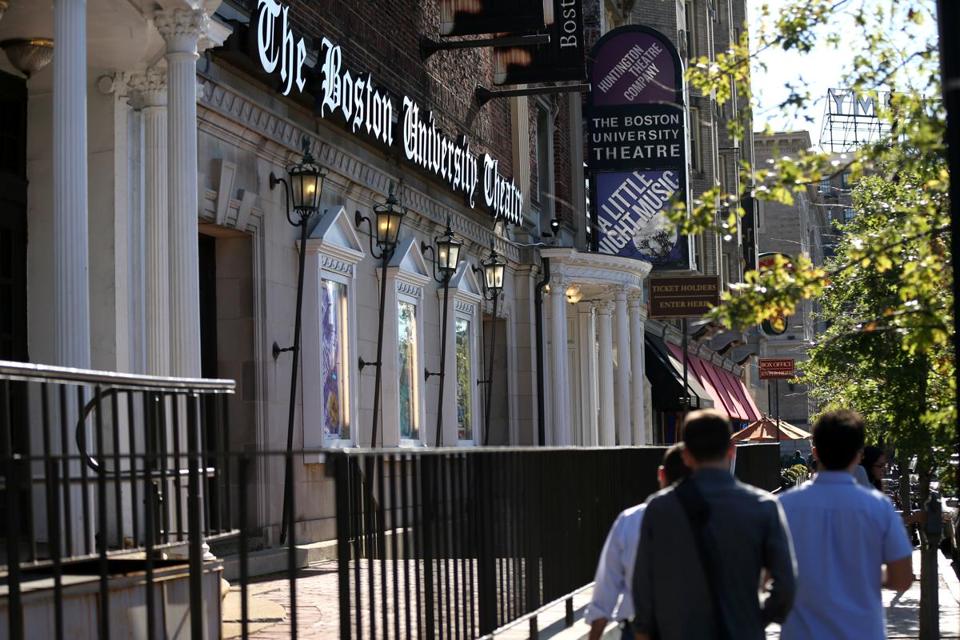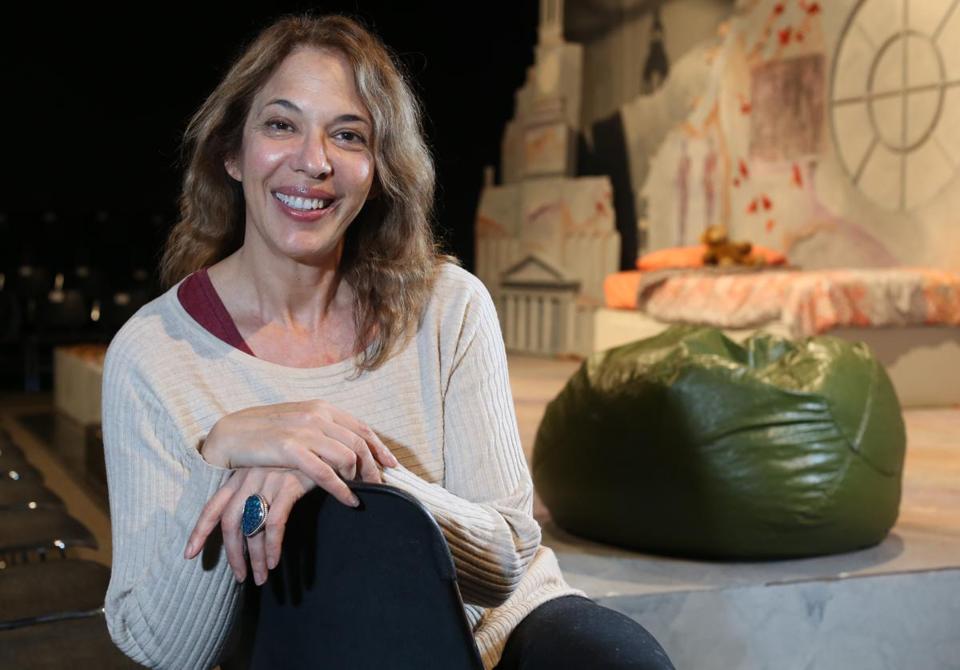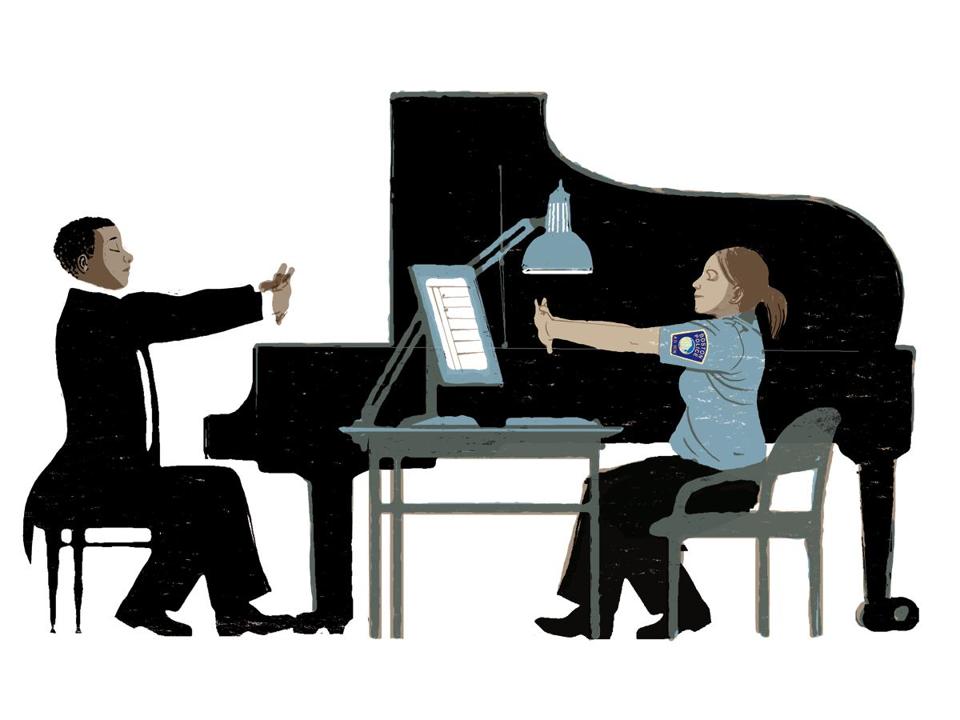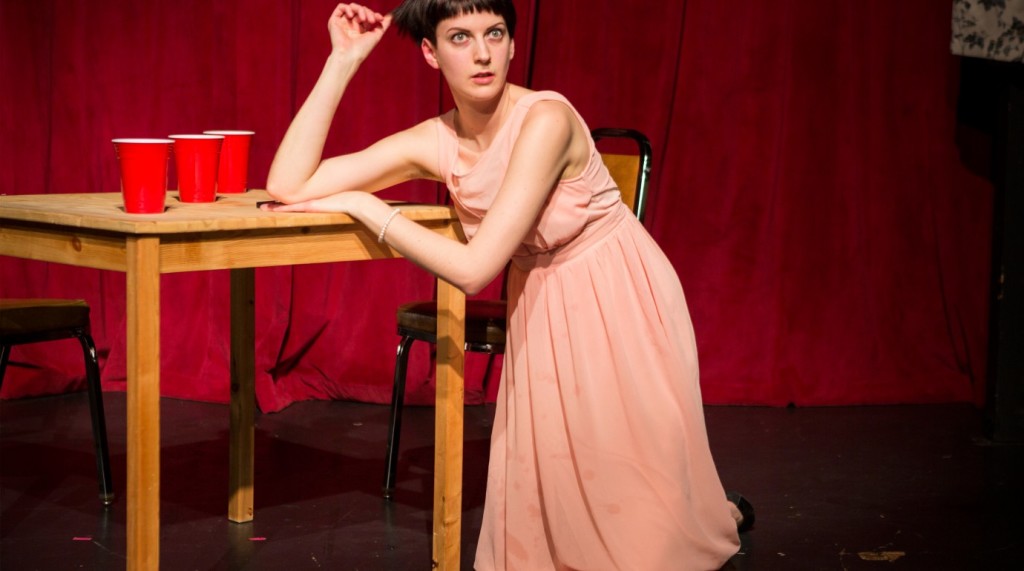available for purchase
at this time.
In The Intersection
Link Roundup! – 4/1/16
April 1, 2016Link Roundups feature articles and bits of internet goodness that our dramaturgy team digs up. If you find something you want to send our way, drop us a line on Facebook or Twitter!
♦♦♦♦♦

Devlin’s set for the musical “American Psycho” at the Almeida Theatre, in London. The production is transferring to Broadway. Courtesy Robbie Jack / Corbis
Set designer Es Devlin and her work is featured in The New Yorker this week:
In theatre terms, this is the age of Es Devlin. She is theatre’s postmodern expert, and has an instinctive sense of how Shakespeare and opera and fashion and pop concerts might draw from the same dark web of psychological information. Each of her designs is an attack on the notion that a set is merely scenery. She is in demand because she can enter the psychic ether of each production and make it glow with significance. She told me, “A stage setting is not a background, it is an environment”—something that directors and actors can respond to. “Sometimes what these people want is a liberator, someone who might encourage them to defy gravity.”
♦♦♦♦♦
Vox reports on the recent controversy about Hamilton‘s casting notice:
As it has everywhere else, diversity has become a flashpoint conversation on Broadway over the past few years. And Hamilton‘s approach to its subject matter — using a blatantly diverse cast to reclaim historical narratives traditionally populated by white actors — has become so iconic that these days on Broadway, “Hamilton casting” is a commonly discussed production strategy. The casting notice recently posted to the show’s website (and later edited) originally explicitly sought nonwhite actors to audition for the lead roles, a way of subverting theater’s typical white-as-default casting bias.
Link Roundup! – 3/25/16
March 25, 2016Link Roundups feature articles and bits of internet goodness that our dramaturgy team digs up. If you find something you want to send our way, drop us a line on Facebook or Twitter!
♦♦♦♦♦
The Boston Globe ran a story about local playwright and actor Melinda Lopez, who was mentioned in President Obama’s speech about Cuba earlier this week:
The president told of how, when Lopez traveled to Cuba and searched for her family’s old home, she had a chance encounter with an elderly woman who had been a neighbor of Lopez’s mother. The woman “recognized her as her mother’s daughter and began to cry” — later producing a baby photo that Lopez’s mother had taken of her infant daughter.
♦♦♦♦♦
The Chicago Tribune has a piece about the subscriber model in the arts and how it mirrors the newspaper business:
In this dilemma, nonprofit arts organizations are not unlike newspapers, such as this one, which are also striving to reinvent themselves for the digital age as their print subscription bases decline. As with the arts organizations, the media executives are trying to go where they think the puck is going, which means embracing the habits of millennials who consume individual stories (the newspaper’s equivalent of individual shows) from many different publications shared on social media. At the same time, the publications remain reliant on the revenue that comes from those still-colossal subscription bases.
Link Roundup! – 3/18/16
March 18, 2016Link Roundups feature articles and bits of internet goodness that our dramaturgy team digs up. If you find something you want to send our way, drop us a line on Facebook or Twitter!
♦♦♦♦♦
 The Boston Globe has a piece about the Performing Arts Facilities Assessment, which is part of the Boston Creates plan:
The Boston Globe has a piece about the Performing Arts Facilities Assessment, which is part of the Boston Creates plan:
Formally known as the Performing Arts Facilities Assessment, the online survey is part of a broader facilities study the mayor announced last November following a series of rapid-fire shifts in the city’s performing arts landscape involving the Colonial Theatre, Citi Performing Arts Center, and BU Theatre. Calling the survey an “essential component” of that broader study, city officials said it would allow them to hear directly from Boston’s performing arts community — both performers and those who provide performance and rehearsal venues.
♦♦♦♦♦
HowlRound has a post by the Latina/o Theatre Commons about cultural microaggressions in arts reviews:
Unintentional or not, cultural microaggressions in reviews should be called out and examined for the harm they cause to a cultural community and to the field of theatrical criticism. Michael Sommers’ musing that Ropes has “no Latino flavor or content” is part of a larger pattern seen in American theatre criticism in which the reviewer imposes their own mistaken expectations onto an artist of color (see the highlighted sections in: Jeffrey Gantz on Edith Can Shoot Things and Hit Them by A. Rey Pamatmat, Charles Isherwood on Mala Hierba by Tanya Saracho and Destiny of Desire by Karen Zacarías, and Charles McNulty on Lydia by Octavio Solis). Such reviews suggest that, for instance, playwrights can only write about culturally specific issues or have characters that fit into the reviewer’s assumptions about that cultural community, of which they are not a part.
Link Roundup! – 3/11/16
March 11, 2016Link Roundups feature articles and bits of internet goodness that our dramaturgy team digs up. If you find something you want to send our way, drop us a line on Facebook or Twitter!
♦♦♦♦♦

Top: Liesl Tommy, Sara Bareilles, Rachel Chavkin and Masi Asare
Bottom: Susan Stroman, Quiara Alegría Hudes, Baayork Lee and Lisa Kron
In honor of International Women’s Day this week, Playbill polled 14 female directors, writers, and composers about the women in the industry to watch:
“I am particularly watching the writing of Dipika Guha: an incredible, nuanced playwright, someone who is smart, political, theatrical and deeply, fiercely emotional. She has been in the Women’s Project lab, and is now being produced across the country (her new work is right now running at Crowded Fire in San Francisco) I worked with her at both Brown and Yale School of Drama, and the range of her work is extraordinary.” – Paula Vogel
♦♦♦♦♦
Vulture lists 28 reasons theatre is thriving right now:
Many trends in the culture had to coalesce to make this happen. To name a familiar one, Glee snuck musical theater back into youth culture, disguised as a tortured-teen soap. But the two most important changes are about the demographics of artists and the taste of audiences. Just as the Jewish play did in the 1940s, and the gay play in the ’80s, stories about race especially — and also gender, class, and other knotty subjects — are emerging as an important engine of even commercial theater. Still, no matter how good, those plays wouldn’t have any effect if audiences resisted their subject matter. Instead, miraculously, they’re embracing it.
Link Roundup! – 3/4/16
March 4, 2016Link Roundups feature articles and bits of internet goodness that our dramaturgy team digs up. If you find something you want to send our way, drop us a line on Facebook or Twitter!
♦♦♦♦♦
Mayor Marty Walsh has an Opinion piece is the Boston Globe this week:
If Boston is going to be a thriving, healthy, and innovative city, we need our artists to flourish. Artists can help solve big problems and heal old wounds. Artists embody the creativity that fuels innovation, and innovation is part of the fabric of Boston. Their work expresses our histories and our values. It communicates our fears, hopes, and dreams. Art brings people together. We see this in the crowds that gathered around the Echelman sculpture on the Greenway last summer, in Illuminus at Fenway, where percussionists “played” the Green Monster, and in our neighborhood festivals and parades. From the beginning of this administration, we identified the arts as a top priority. And we recognized that supporting the arts begins with supporting artists’ work. Without our artists, we aren’t Boston.
♦♦♦♦♦
American Theatre has a feature about the Write With Us program at Soho Rep, which allows the public to come in for writing workshops led by Soho Rep playwrights:
Martin and Benson invited the participating writers—which also included Annie Baker, Greg Moss, and Daniel Alexander Jones—to format their three-hour workshop however they wanted. César Alvarez had attendees write lyrics, to which he would compose a melody and start to craft a song, while Anne Washburn conducted her entire workshop in the dark and had students bring flashlights. “It was this very sort of sonic experience,” says Benson, who attended all of the writer’s workshops.
Link Roundup! – 2/26/16
February 26, 2016Link Roundups feature articles and bits of internet goodness that our dramaturgy team digs up. If you find something you want to send our way, drop us a line on Facebook or Twitter!
♦♦♦♦♦

The playwright Kirsten Greenidge, whose “Baltimore” is a beneficiary of the Big Ten New Play Initiative. Credit Kayana Szymczak for The New York Times
The New York Times highlights C1 playwright alum Kirsten Greenidge in a story about the Big Ten New Play Initiative:
Giving more such practice to female undergraduates is a major objective of the program that commissioned “Baltimore” and is rolling it out in productions at several universities this academic year. The Big Ten New Play Initiative — yes, schools better known for football or basketball are behind it — has begun seeding the canon with a fresh crop of works by women.
Naomi Iizuka, Rebecca Gilman and Madeleine George are the other playwrights tapped so far for the project, which is intended in part to address one of American theater’s most pressing concerns: the need to put more plays by women onstage. But the initiative goes a significant step further. Each script is bound by just one rule, said Alan MacVey, who oversees the $10,000 commissions: It must include at least six substantial roles for young women.
♦♦♦♦♦
A group of 27 women and people of color talk about what it’s like to work in Hollywood for a huge feature for the New York Times:
In 1985, I’m sitting in the casting office of a major studio. The head of casting said, “I couldn’t put you in a Shakespeare movie, because they didn’t have black people then.” He literally said that. I told that casting director: “You ever heard of Othello? Shakespeare couldn’t just make up black people. He saw them.” I started carrying around a postcard of Rubens’s “Studies of the Head of a Negro.” The casting director actually was very kind to me. He referred me to my first agent.
Link Roundup! – 2/19/16
February 19, 2016Link Roundups feature articles and bits of internet goodness that our dramaturgy team digs up. If you find something you want to send our way, drop us a line on Facebook or Twitter!
♦♦♦♦♦
The Boston Globe has a feature on Boston’s new artist-in-residence program:
Imagine a dancer working with police officers to better interpret a suspect’s gait. Or a musician teaching a city parking clerk how to listen deeply. Or an abstract painter rearranging a tangle of contradictory street signs. That’s the idea behind Boston’s new artist-in-residence program, which will embed local artists inside city departments to promote creative thinking about municipal government.
♦♦♦♦♦
StageSource Executive Director (and recent C1 PlayLab guest speaker!) Julie Hennrikus wrote an editorial for the ARTery about arts space and funding in Boston:
We are in the midst of a social revolution right now, and cultural equity is part of it. Cultural equity requires acknowledging, addressing and dismantling the systemic and social inequities that are built into the fabric of our society. We can’t achieve what is possible unless we acknowledge that even in the arts, which are supposed to be a great equalizer, inequity persists.
Do we really care about cultural equity? That is an important conversation, and speaks to Boston’s history and its future. We have to care. The arts community has the opportunity to be a leader on this front in a way that would change the city. Could different funding streams help? When companies rely on ticket sales to the degree that they do in Boston, fear of change becomes ingrained. Rethinking offerings, audiences, locations, art forms — all of that requires change.
Link Roundup! – 2/12/16
February 12, 2016Link Roundups feature articles and bits of internet goodness that our dramaturgy team digs up. If you find something you want to send our way, drop us a line on Facebook or Twitter!
♦♦♦♦♦
American Theatre has a feature on the ongoing copyright dispute surrounding the performance piece That’swhatshesaid in Seattle:
That’swhatshesaid, performed for a four-night run last week in a 50-seat venue at Gay City Arts in Seattle, is a new work inspired by a growing frustration with the role of women in theatre, and constructed from the words of leading playwrights. Three young queer artists—director Hatlo, playwright Courtney Meaker, and creator/performer Erin Pike—worked for two years to make it. In setting out to draw attention to the ways in which women’s voices are rendered and their bodies presented onstage, they took pieces of dialogue and stage directions from the 11 plays listed by American Theatre as the most-produced plays of the 2014-2015 season. The Whipping Man was on the list, as were David Ives’s Venus in Fur, Christopher Durang’s Vanya and Sonia and Masha and Spike, Nina Raine’s Tribes, and Joshua Harmon’s Bad Jews. Of the 11 plays, only 2 were by women (the other was Amy Herzog’s 4000 Miles).
♦♦♦♦♦
An essay on Vox explores the inequalities faced by artists of color in the acting industry:
I write a note to my Facebook friends condemning a theater culture that would let this happen. I explain that these sorts of racially charged interactions happen regularly and that they have, multiple times, almost made me quit the business. I juxtapose the difficulty of getting cast in theater due to my color, since the canon historically ignores minorities, with the knowledge that when we do get cast, these are the types of situations we find ourselves in. I finish by remarking that my career will probably be hurt more for speaking out against this culture than that white actor’s career will be hurt for calling me “nigger” on stage.
C1 PlayLab: What We’re Reading – Vol. 1
February 10, 2016We recently kicked off the newest iteration of C1 PlayLab, and in the coming months, we’ll be using some of our time during our PlayLab Master Classes to discuss big ideas and current issues that are relevant to working playwrights. This month we are exploring the themes of Character and Identity — here are a few pieces of writing that will serve as a springboard for our conversation during this month’s PlayLab session.
♦♦♦♦♦
My Parents Were Tiger People: christopher oscar peña chats about writing race with A. Rey Pamatmat via HowlRound
A. Rey Pamatmat is our PlayLab guest this month, and this conversation is a great one to get us thinking about how one’s personal identity and experience can impact a play, as well as what it means to craft characters from a variety of backgrounds:
People need to be okay with labels evolving and redefining themselves. I also wish plays were experienced on their own. The context of the writer’s identity is totally exciting…afterward. Let that add to the conversation, not be it.
♦♦♦♦♦
Artistic Authority Series – Part One and Part Two via Jacqueline Lawton’s blog.
In these two posts, playwrights Kia Corthron, Jorge Ignacio Cortiñas, Kristoffer Diaz, Marcus Gardley, and several others all offer their thoughts on the ethics of writing characters from a different racial or ethnic identity than one’s self.
Are we ethically entitled to write outside of our own ethnicity (however we define any of those loaded terms)? If we do, are there any ground rules? Are we obligated to educate ourselves (even minimally) about a culture before assuming the authority to give voice to characters of that culture? Or is any such suggestion a hindrance to the creative process, at worst tantamount to censorship?
Link Roundup! – 2/5/16
February 5, 2016Link Roundups feature articles and bits of internet goodness that our dramaturgy team digs up. If you find something you want to send our way, drop us a line on Facebook or Twitter!
♦♦♦♦♦
The Atlantic has an article exploring the history and future of the National Endowment for the Arts as it approaches its 50th anniversary:
Fifty years ago, the National Endowment for the Arts was created to address just such inequity. On September 29, 1965, President Lyndon B. Johnson signed the National Endowment for the Arts into existence, along with a suite of other ambitious social programs, all under the rubric of the Great Society. Johnson imagined these programs as ways to serve “not only the needs of the body and the demands of commerce but the desire for beauty and the hunger for community.”
Half a century later, the ethos upon which the NEA was founded—inclusion and community—has been eroded by consistent political attack. As the NEA’s budget has been slashed, private donors and foundations have jumped in to fill the gap, but the institutions they support, and that receive the bulk of arts funding in this country, aren’t reaching the people the NEA was founded to help serve. The arts aren’t dead, but the system by which they are funded is increasingly becoming as unequal as America itself.
♦♦♦♦♦
Jack Reuler, Artistic Director of Mixed Blood Theatre in MN, lists 111 Nuggets for Being a Successful and Ethical Artistic Director on HowlRound:
Years ago a St. Paul kindergartener named Reuler was asked to demonstrate that he could count. As he got into three digits, he counted one hundred eight, one hundred nine, eleventy, eleventy-one… at which time he was stopped by his teacher and corrected, being told that it is, correctly, one hundred ten and one hundred eleven. The five-year-old responded “If 81 is eighty-one and 91 is ninety-one, then 111 is eleventy-one!” and held his ground. While that may have, in another time, led to a diagnosis of oppositional defiance disorder, that young contrarian became determined to live a life in which things aren’t always what they appear to be or what others name them to be. My fascination with the symmetry of numbers remains to this day and so having 111 (eleventy-one) nuggets that I have gleaned through decades of leading a regional theatre in America will, hopefully, save years of discovery through trial and error for new artistic directors.



